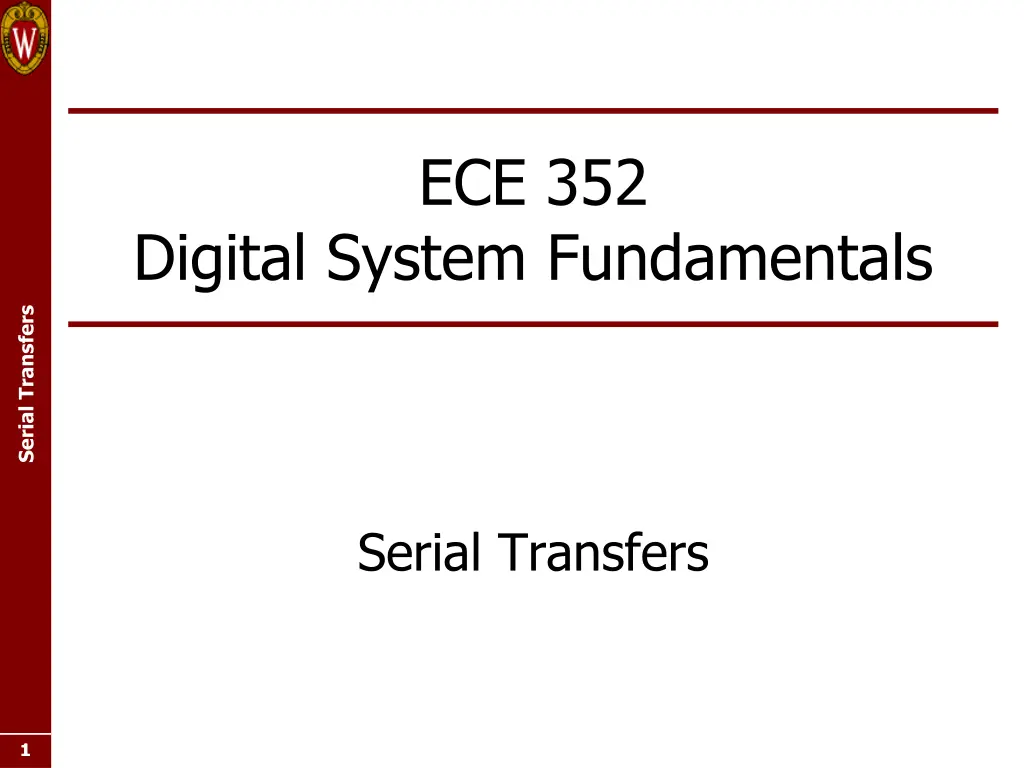
Understanding Serial Data Transfers
Learn about the advantages and trade-offs of serial data transfers in digital systems, including reduced interconnections, cost savings, and practical examples using shift registers. Explore when serial transfers are appropriate and how they compare to parallel operations.
Download Presentation

Please find below an Image/Link to download the presentation.
The content on the website is provided AS IS for your information and personal use only. It may not be sold, licensed, or shared on other websites without obtaining consent from the author. If you encounter any issues during the download, it is possible that the publisher has removed the file from their server.
You are allowed to download the files provided on this website for personal or commercial use, subject to the condition that they are used lawfully. All files are the property of their respective owners.
The content on the website is provided AS IS for your information and personal use only. It may not be sold, licensed, or shared on other websites without obtaining consent from the author.
E N D
Presentation Transcript
ECE 352 Digital System Fundamentals Serial Transfers Serial Transfers 1 1
Serial Transfers The register transfer operations we have seen so far have been parallel All bits in a register (the data word) are transferred and/or operated on at once Serial Transfers An alternative is use a serial approach In a serial transfer, a data word is transferred one bit at a time, eventually transferring the entire data word A serial operation is performed on one bit of the data word at a time, eventually completing the operation on the entire data word 2 2
Why Do It Serially? A serial data transfer reduces the number of interconnections between registers Data can be transferred between n-bit registers using a single data connection instead of n data connections For transfers between devices, this reduces the number of interconnections between device and the number of pins required on the devices Serial Transfers Serial operations reduce the hardware costs For example, an n-bit addition can be completed with only a single full adder 3 3
At What Cost? The trade-off is speed Of course, if the data is being transferred serially, operating on it serially isn t any slower In reality, it is even more complicated A serial operation takes longer than the corresponding parallel operation n 1-bit transfers versus a single n-bit transfer n 1-bit additions versus a single n-bit addition Serial data transfers and operations are appropriate when reduced speed is not an issue, or other factors are more important Serial data transfers are extremely common in practice Serial Transfers 4 4
Serial Transfer Example Shift registers are used at both ends The same clock must be used at both ends! Load the parallel data into the source shift register Simultaneously shift data out of the source register and into the destination register After n clock cycles, the parallel data can be read from the destination shift register Serial Transfers DIN n din[] RSR load clk so si LD TSR clk dout[] n CLK DOUT What s missing? 5 5
Serial Operation Example Use one full adder to perform an n-bit addition Load the operands into two n-bit shift registers Do the addition one bit at a time, starting from the least significant bit Need to know the carry from the previous addition Shift the operands right one bit at each clock Store each bit of the result in a shift register, shifting in at the most significant bit Can use an operand register to store the result! After n clocks, addition is complete and the result is available in the shift register Serial Transfers 6 6
Serial Adder Circuit Use one full adder to perform an n-bit addition Load the operands into two n-bit shift registers A n Serial Transfers si din[] so load sh clk A dout[] S n B COUT CIN B n din[] so 1 0 load sh clk D RST Q LD SH CLK SUM 7 7
Serial Adder Circuit Do the addition one bit at a time, starting from the least significant bit A n Serial Transfers si din[] so load sh clk A dout[] S n B COUT CIN B n din[] so load sh clk D RST Q LD SH CLK SUM 8 8
Serial Adder Circuit Store each bit of the result in a shift register, shifting in at the most significant bit A n Serial Transfers si din[] so load sh clk A dout[] S n B COUT CIN B n din[] so load sh clk D RST Q LD SH CLK SUM 9 9
Serial Adder Circuit After n clocks, addition is complete and the result is available in the shift register A n Serial Transfers si din[] so load sh clk A dout[] S n B COUT CIN B n din[] so load sh clk D RST Q LD SH CLK SUM 10 10
Serial Adder Circuit So, how do you control this circuit? Design a control unit FSM! A n Serial Transfers si din[] so load sh clk A dout[] S n B COUT CIN B n din[] so load sh clk D RST Q LD SH CLK SUM 11 11
ECE 352 Digital System Fundamentals Serial Transfers Serial Transfers 12 12
